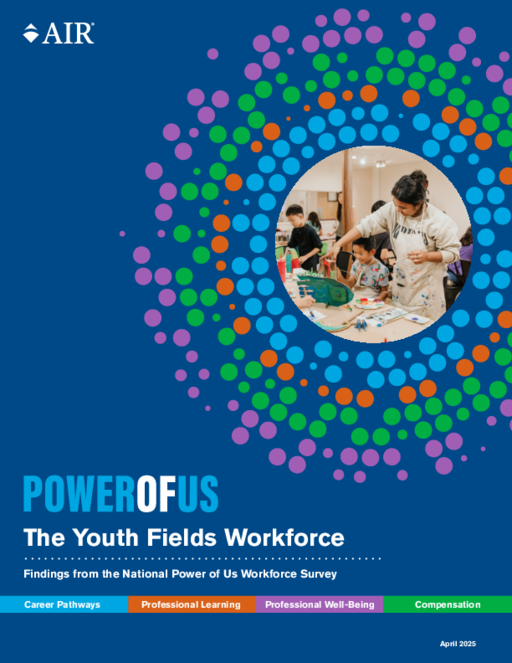Breadcrumb
- Wallace
- Reports
- Power Of Us: The Youth Fields Wo...
Power of Us: The Youth Fields Workforce
Findings from the National Power of Us Workforce Survey

Overview
More
Less
- Author(s)
- Deborah Moroney, Megan E.M. Brown, Anne E. Diffenderffer, Deepa S. Vasudevan, Jill Y. Richter, Rachel Carroll, Amy K. Syvertsen, and Gislene N. Tasayco Prado
- Publisher(s)
- American Institutes for Research
Summary
How we did this
This first-of-its-kind survey offers comprehensive insights into the youth fields workforce: paid staff and volunteers who work with youth beyond school hours, beyond the school year, and outside of classroom settings. Over 10,000 current and former youth fields staff and volunteers from all 50 U.S. states, the District of Columbia, and Guam participated in the survey. Data collection began on February 22, 2022 and ended on March 31, 2023. This report reflects the responses from the more than 7,000 respondents who were in paid positions in the workforce at the time of the survey.
Adults who work with youth beyond school hours, beyond the school year, and outside of classroom settings play an essential role in young people's development. They hold jobs in a range of settings, including school- and community-based afterschool programs, summer learning programs and camps, sports, library and museum programs, youth employment programs, and more.
Until now, there was little systematically collected and aggregated information about the people who make up this youth workforce, such as why they took these positions, why they stay in them, and what supports they need to do their jobs.
Findings from the Power of Us, a national workforce survey conducted by the American Institutes for Research (AIR), can help broaden and deepen what we know about the people who serve in these roles, with findings related to their backgrounds, dedication to youth development, career paths, and needs in professional learning, well-being, and compensation. The survey is part of a larger Youth Fields Study, which was designed to respond to the long-standing need to update, broaden, and deepen understanding of who works with the nation’s young people.
The report draws from a survey of more than 7,000 youth-serving professionals and volunteers. It provides insights into the varied backgrounds, career paths, and experiences of those working with young people outside of the traditional school day and school year.
The report features key findings that the researchers divided into the four overriding categories:
- Career Pathways: Entry into the Youth Fields workforce, career progression, future employment
- Professional Learning: Career preparation, professional learning supports
- Professional Well-Being: Working conditions, inclusion, stress and burnout
- Compensation: Pay, benefits
This report is considered a valid baseline of youth fields staff and their experiences. According to researchers, understanding the motivations and experiences of this workforce is crucial to recruiting and retaining staff in these roles and improving their experiences at work.

Whether they go by “mentor,” “counselor,” or “afterschool practitioner,” the adults in the youth fields workforce are essential contributors to children’s learning and development beyond formal schooling.
Key Takeaways
- Career Pathways: 62% of respondents first joined the youth fields due to a sense of purpose and commitment. They are drawn to and stay in the youth fields because they enjoy working with youth, find purpose in it, and have a personal connection to the communities, places, and experiences of the young people they support.
- Professional Learning: 84% of respondents have access to professional learning through their organization and are eager learners. While many respondents have postsecondary degrees, there is no common educational pathway into the youth fields. There is a critical need for organizations to provide the time, space, and guidance for on-the-job training, as educational backgrounds and access to professional learning vary greatly.
- Professional Well-being: 87% of respondents agreed or strongly agreed they felt valued at work, but 47% feel burned out. Strengths identified by respondents include working conditions and inclusion, with opportunities to improve these experiences for some respondents and—for many—to reduce stress and burnout.
- Compensation: 88% of respondents in leadership positions earn less than school principals. Compensation and benefits are important, and respondents are craving more support. The Power of Us Workforce Survey data uncovers the realities of pay and aspirations for more fair benefits in the youth fields and elevates the need for the recruitment and retention of qualified staff in the youth fields.
Visualizations


Materials & Downloads
What We Don't Know
- Because there is no existing baseline data, it is not clear the extent to which this survey sample represents the youth fields workforce as a whole.
- Despite extensive outreach, the majority of survey respondents represent leadership positions in their organizations. What factors may have limited the response rates of frontline staff?

